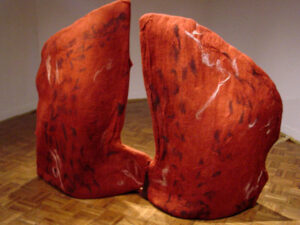Gail Tremblay and Alfredo Arreguin
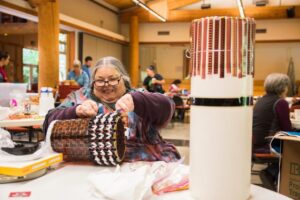
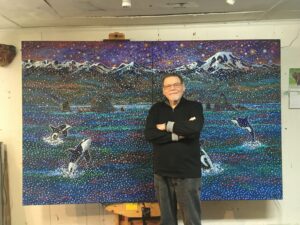
Memorials for Gail Tremblay (1945 – 2023), Alfredo Arreguín, (1935 – 2023)
This summer we had memorials for two special artists, both deeply concerned about our planet: Gail Tremblay, Native American poet and multimedia artist, and Alfredo Arreguín, Mexican and American painter. Gail Tremblay was a close friend for many years, I only met Alfredo once when I interviewed him for an article. The memorials were equally moving, although approached in different ways. In each case, I learned a great deal about the artists.
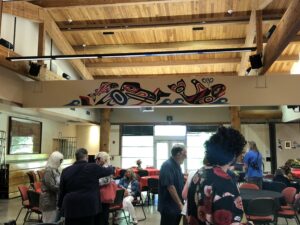
Gail Tremblay, of Mi’kmaq and Onondaga descent, was a long time professor at The Evergreen State College. The memorial took place at the House of Welcome Cultural Arts Center on the college campus. We heard about her huge role at Evergreen since the 1980s in creating a Native arts program, as well as mentoring students of all backgrounds. Called an “Artistic and Teaching Retrospective” it included testimonials to her importance as an educator, readings of her poetry, and a celebration of her art career.
I knew Gail mainly as a poet and a visual artist who addressed difficult topics in original mixed media formats.
The last time I talked to her, she read me some of her new poetry on the phone. What a wonderful experience. She was still writing in spite of many physical issues.
I have written about her art work for many years, as well as reviewing group exhibitions that she curated such as “Voices of Water” and “Not Vanishing. Contemporary Expressions in Visual Art.” Her striking installations addressed ecological disasters such as cancer from pollution at Hanford- “It is Heavy on My Heart,”
– and the loss of salmon-“Empty Fish Trap.”
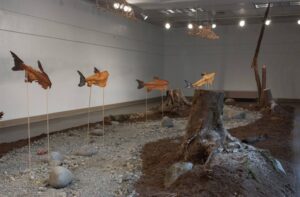
She incorporated recorded narratives, video, photographs, and poetry into her installations.
She was best known for her film baskets woven from 35 mm film addressing the racism of Hollywood.
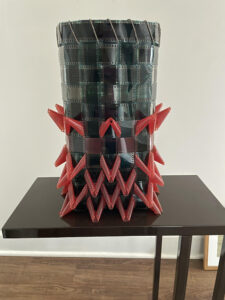
As I wrote in 2003:
“Gail Tremblay weaves our spirits into these artworks and takes us on a journey with her extraordinary technical ability, her words, her deep caring for the earth, and her sense of humor. On the journey we enter small worlds and large worlds, the outer universe and the inner universe. She hopes that we end up caring about all of it as much as she does.”
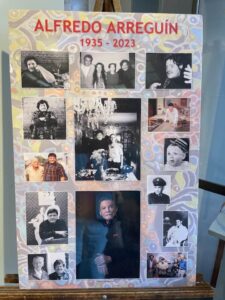
The memorial for Alfredo Arreguín on Whidbey Island at the Schouten Gallery featured an exhibition of his works in the gallery that surrounded us with his brilliant invocations of nature.
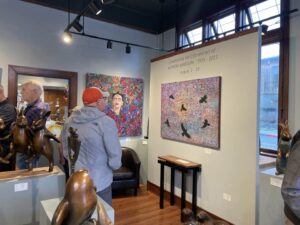
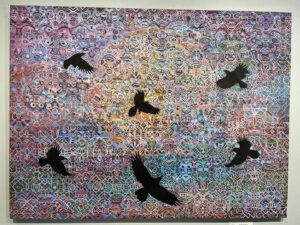
Arreguin started exploring the theme of Frida Kahlo many years ago, before she was a household name.
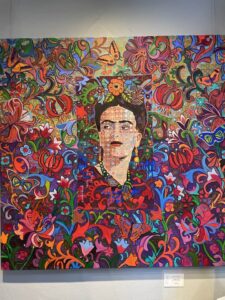
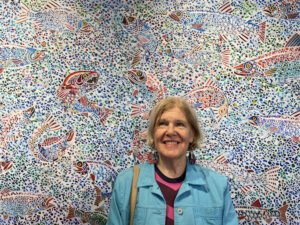
Arreguín’s painting is extraordinarily detailed, it includes layers of intricate patterns with faces emerging from them, or birds and monkeys immersed in deep jungle scenes.
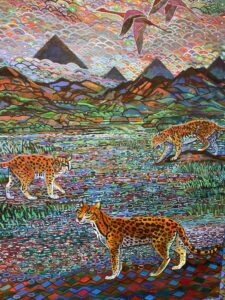

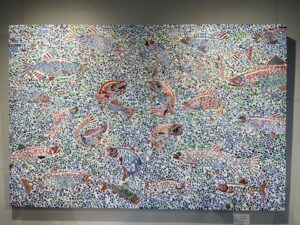
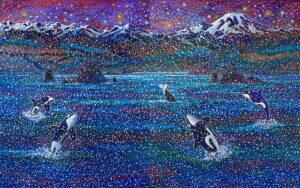

I took this photograph when I visited him for an article for South Seattle Emerald. they wanted too much rewriting, so I posted it on my blog instead.https://www.artandpoliticsnow.com/2019/08/a-visit-to-the-home-of-alfredo-arreguin-and-susan-lytle-june-2019/
I also included in my book, Setting Our Hearts on Fire.
While he talked to me, he turned around from time to time and added a dot to the painting. Here is a detail.
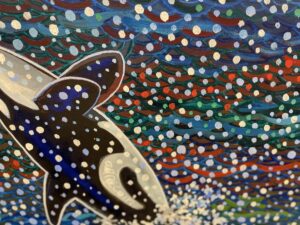
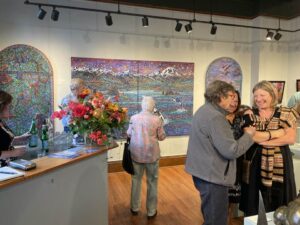
Arreguín’s paintings both celebrate and grieve for the loss of our rich biodiversity. As he stated, “We are the most dangerous animals on the planet.”
The next day the memorial featured informal statements by close friends in the garden of the gallery. The event was led by eminent poet Tess Gallagher. She and her husband, writer Raymond Carver (1938-88), were dear friends of Alfredo and Susan Lytle. Gallagher read “Reaching” a poem she wrote for him when he gave her the painting Green- Eyed Poet.
Lauro Flores, chair and professor of Ethnic Studies at the University of Washington and author of Alfredo Arreguín Patterns of Dreams and Nature spoke eloquently. Jeff Day, sculptor, and long time personal friend of Alfredo and Susan spoke about the Blue Moon Café, that famous bar in the UDistrict where many of Alfredo’s friends first met.
Both memorials honored the artists through the invocation of their lives and creativity. But what came across most clearly for both Alfredo Arreguín and Gail Tremblay was their vivid spirits, generous friendships, and extraordinary originality as creative people.
Arreguín painted leaping orcas in Puget Sound in several versions. Shortly after Arreguín’s memorial we heard of the death of Tokitae, an Orca captured on August 8, 1970 in Penn Cove, Whidbey Island the only survivor of hundreds captured. She spent her life in a small tank at the Miami Seaquarium. After many years of effort, she was about to be returned to her home pod in the Northwest.
Tragically, immediately after her death, the decision was made by the Aquarium to have Tokitae undergo an autopsy, so her body has been cut up. This is an additional shock to the Lummi since they weren’t consulted.
Now the Lummi have decided to cremate the remains and bring the ashes back home.
This entry was posted on August 28, 2023 and is filed under Uncategorized.




